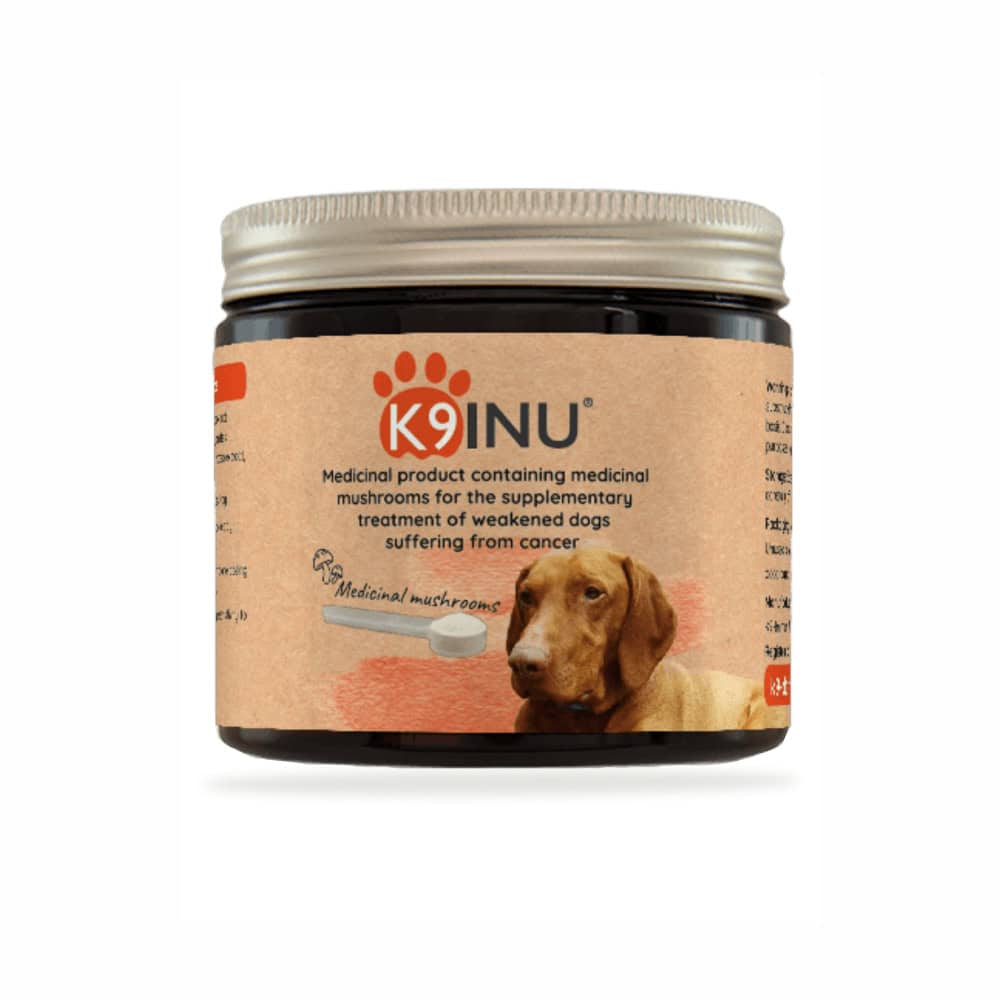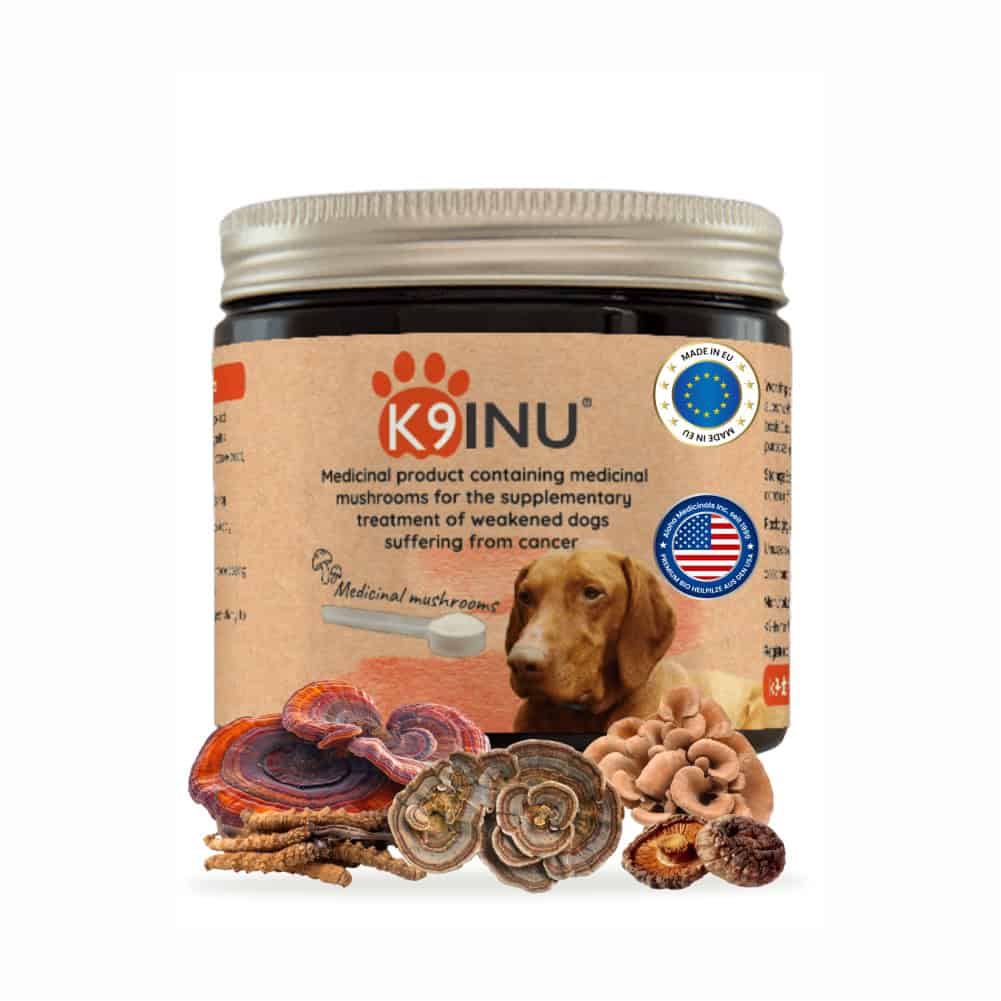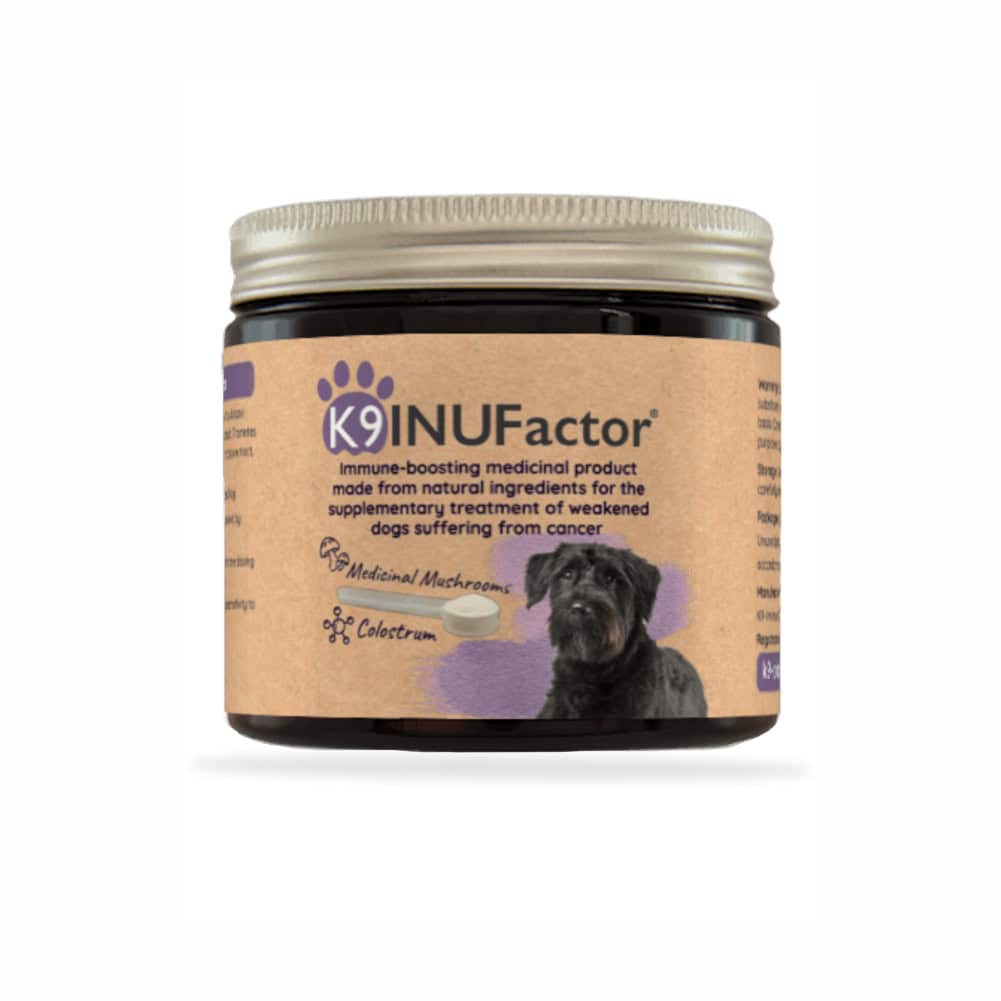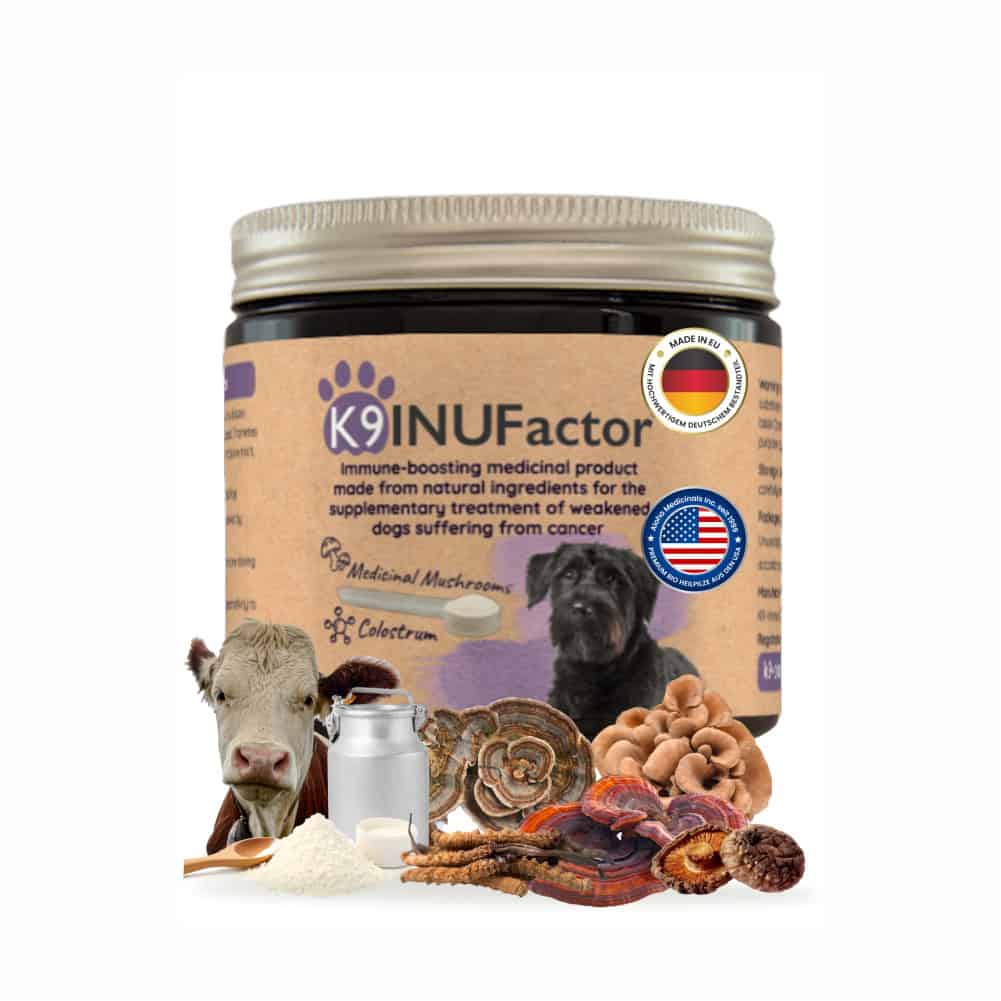Dog mammary tumor – if you feel a lump on your dog’s mammary gland, it is always a cause for concern. This is one of the most common cancers in dogs. Unfortunately, the risk of mammary cancer in dogs is several times higher than in humans. That is why it is crucial for owners to know the symptoms, causes, and treatment options. Early detection can save lives and help your dog enjoy more happy, healthy years by your side. Finding a lump on your dog can be frightening, but remember: with early action and proper care, many dogs continue to live happy, fulfilling years.
Development of mammary tumors
The development of a dog mammary tumor is a complex process involving hormonal, genetic, and environmental factors. The disease is far more common in females, but it can rarely occur in males. In those cases, it usually has a more aggressive course and a worse prognosis.
Hormonal influence plays a key role: estrogen and progesterone levels affect the functioning of mammary gland tissues. That is why early spaying significantly lowers the risk of mammary cancer in dogs. The more heat cycles a female goes through without being spayed, the higher the chance that a mammary gland tumor will develop.
Genetic predisposition is also important. Certain breeds – such as the German shepherd, spaniels, English setter, miniature poodle, Maltese, and Yorkshire terrier – are more prone to mammary gland tumors. International statistics also show high prevalence in poodles, dachshunds, cocker spaniels, and German shepherds.
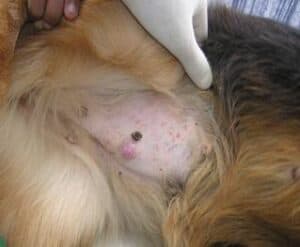
Environmental and lifestyle factors can also contribute to the risk. Obesity, poor diet, hormone-based medications, or false pregnancies may all increase the likelihood of canine mammary tumors. They typically develop around 10–11 years of age and very rarely occur in dogs under 5 years old.
Which dog breeds are more prone to mammary tumors?
- German shepherds, spaniels, English setter
- Miniature poodles, Maltese, Yorkshire terriers
- According to international data: poodles, dachshunds, cocker spaniels, and German shepherds are particularly affected.
Mammary tumor risk factors
The highest risk group includes unspayed females over 2 years old. In this group, the occurrence of mammary tumors is nearly 30%, meaning every third female dog develops mammary cancer.
Therefore, the best prevention is early spaying.
Moreover, if you are not planning to breed professionally, spaying also prevents unintentional breeding and reduces the problem of overpopulation.
A few statistics:
- Spaying before the first heat: 0.5% risk of mammary cancer.
- Spaying after the first heat: 8% risk.
- Spaying after the second heat: 26% risk.
About half of all mammary tumors in dogs are benign, while the other half are malignant.
Symptoms of dog mammary tumors
The first sign of a dog mammary tumor is often a slowly growing lump or swelling around the mammary glands. These lumps are often painless, so owners may not notice them at first. Over time, the tumor surface can ulcerate, become inflamed, and show discharge, bleeding, or foul odor.
The symptoms differ depending on whether the tumor is benign or malignant. Benign tumors usually grow more slowly and rarely spread. Malignant canine mammary tumors grow faster, invade surrounding tissues, and may form metastases in the lungs, liver, or lymph nodes.
Metastases can cause further symptoms such as coughing, labored breathing, loss of appetite, sudden weight loss, or general weakness. That is why any lump in the mammary area should be examined by a veterinarian, even if it seems harmless at first. For owners, these changes can be heartbreaking to see. But don’t lose hope – veterinary medicine has advanced, and with timely care, many dogs regain a good quality of life.
If you notice such symptoms, do not wait – consult a veterinarian immediately. Early action can save your dog’s life.
-
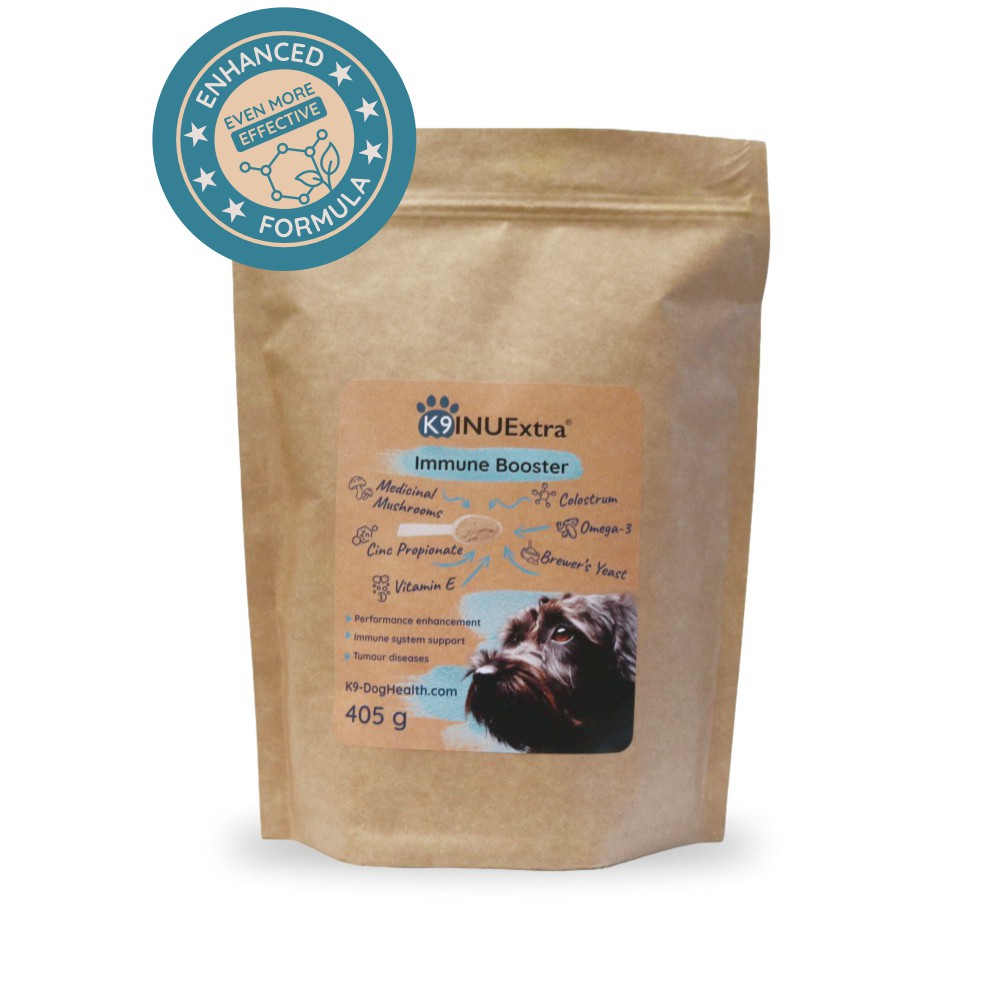

K9 INUExtra®
- Premium immune support with medicinal mushrooms and colostrum
- Anti-inflammatory support with curcumin, omega-3 and BioPerine
- Stronger gut flora and improved digestion with brewer’s yeast and targeted prebiotics
- Antioxidant cellular protection with vitamin E, zinc and natural active compounds
€78,60
Importance of early detection
The outcome of a dog mammary tumor strongly depends on the stage at diagnosis. The earlier the disease is detected, the better the chances of complete recovery and a longer, good-quality life. Tumors that are found early and have not yet metastasized can often be completely removed by surgery, which may extend the dog’s life by years.
Owners play a crucial role. At home, you should regularly check your dog’s mammary glands, especially after the age of 5, when the risk rises significantly. If you feel even a small lump, swelling, or tender spot, visit your vet without delay.
Veterinary examinations usually include not only palpation but also imaging tests (X-ray, ultrasound) to check the internal organs and potential metastases, as well as cytology or histopathology to determine if the tumor is benign or malignant.
Treatment of dog mammary tumors
The treatment of dog mammary tumors primarily involves surgery. However, the exact surgical plan depends on the size, location, and type of the tumor and on the dog’s overall health. The aim is to remove as much tumor tissue as possible while maintaining a good quality of life.
The veterinarian may choose from several surgical options:
- Lumpectomy: removing only the tumor, used in small, clearly localized benign cases.
- Partial mastectomy: removal of the tumor and the surrounding mammary tissue.
- Total mastectomy: removal of the entire mammary gland, recommended in advanced or malignant tumors, often together with nearby lymph nodes.
- Sequential mastectomy: removal of several mammary glands on one or both sides, performed in stages in severe cases.
After surgery, the histopathological examination of the removed tissue is always necessary to determine the exact type of the tumor, its malignancy, and the need for further treatment.
In addition to surgery, chemotherapy is often required in malignant cases to reduce the risk of metastasis. Radiotherapy is less common but may be considered as an additional treatment in advanced cases. In every situation, the veterinary oncologist will create an individualized treatment plan.
Aftercare
After surgical removal of a dog mammary tumor, the recovery period significantly affects the outcome. Most dogs feel more active already the day after the surgery, but full recovery may take a few weeks.
Aftercare is essential and includes:
- Wound protection: an Elizabethan collar prevents licking or scratching the stitches.
- Pain relief and antibiotics: proper administration of prescribed medication is crucial.
- Activity restriction: avoid running, jumping, or excessive activity during the first 10–14 days.
- Wound monitoring: check the surgical site daily for swelling, discharge, or wound separation.
Regular check-ups are essential for early detection of recurrence or metastasis. Every 3 months during the first year and every 6 months thereafter, your dog should undergo veterinary control (physical exam, X-ray, or ultrasound).
Prognosis and survival
The prognosis of dog mammary tumors depends on the type, size, and stage of the tumor and on whether metastasis is present. Early-stage, surgically removed tumors offer much better chances of recovery. The smaller the tumor at the time of surgery, the longer the survival and the better the quality of life.
In general:
- Benign mammary tumor: surgery often results in a complete cure, and the dog may live a long, full life.
- Malignant mammary tumor: higher risk of recurrence and metastasis, making regular check-ups vital.
- Metastatic tumor: prognosis is worse, survival often limited to months, but appropriate therapy can improve quality of life.
Scientific data show that with early detection and surgery, dogs may live for 2–3 years in good quality of life. In advanced, metastatic cases, survival often drops to a few months. Chemotherapy and immunomodulatory therapy can help slow disease progression and improve well-being.
Every dog is unique. Even if the numbers sound discouraging, remember that many dogs beat the odds thanks to dedicated care, strong immunity, and the love of their families.
Dog mammary tumor and immunomodulatory therapy
In treating dog mammary tumors, surgery and, if needed, chemotherapy are the main therapeutic options. These methods aim to remove the tumor and ease the burden on the body. However, they are often not enough on their own. This is where immunomodulatory therapy comes in, strengthening the dog’s immune system so it can recognize and fight tumor cells.
The essence of immunomodulatory therapy is twofold: first, traditional treatments (surgery, chemotherapy, radiotherapy) reduce the tumor mass, and they help stabilize the dog’s condition. Second, the immune system is activated so it can eliminate the remaining cancer cells, and as a result, the overall treatment becomes more effective. This significantly improves long-term survival chances and life quality.
The K9 INU® and K9 INUExtra® products contain six different medicinal mushrooms. These contain heteropolysaccharides, proven to boost the immune response and provide anti-tumor and anti-metastatic effects.
While surgery and chemotherapy aim to remove existing tumors, immunomodulatory therapy helps the dog’s body actively fight abnormal cells. This reduces the risk of recurrence and increases the chance for a longer, good-quality life.
Strengthening the immune system is not only vital in dog mammary tumors but also in other cancers such as lymphoma, osteosarcoma, brain tumors, and mast cell tumor. Without involving the immune system, there is no true healing, only symptomatic treatment.
Lifestyle & supplements
The treatment of canine mammary cancer does not end with surgery or medication. Instead, long-term care involves proper lifestyle and nutrition. A balanced, natural diet, regular exercise, and targeted supplements strengthen the immune system, support recovery, and improve quality of life.
Among supplements, medicinal mushrooms play a key role due to their proven immunostimulant and anti-cancer effects. In addition, krill oil (K9 INUKrill®), vitamin C, and probiotics also support immunity and recovery after surgery.
Besides nutrition, regular, moderate exercise is also essential. Daily walks and gentle activity improve well-being, maintain muscle mass, and help prevent obesity, an independent risk factor for several cancers, including mammary tumors.
In addition to veterinary treatment, owners should actively support their dog’s immunity and lifestyle. To strengthen your dog’s defenses, check out our immune-supporting products for dogs.
Dog mammary cancer raises many questions for owners: how to prevent it, how dangerous it is, what surgery means, and what the chances are. Below we have collected the most common questions and answers to help you navigate this topic more easily.
Faq about dog mammary tumors
❓ Can dog mammary tumors be prevented?
Yes, early spaying is the most effective prevention. Spaying before the first heat cycle almost eliminates the risk of developing mammary cancer in dogs.
❓ Are mammary tumors painful for dogs?
At first, they usually appear as painless lumps. In advanced stages, however, inflammation, ulceration, discharge, and metastases can cause pain.
❓ how long can a dog live with mammary cancer?
However, it depends on the type and stage of the tumor. With early detection and successful surgery, a dog may live for 2–3 years in good quality. In advanced, metastatic cases, survival is often measured in months.
❓ is chemotherapy always necessary?
Not always. In benign cases, surgery alone may be sufficient. In malignant or metastatic tumors, chemotherapy can help reduce recurrence.
❓ can male dogs develop mammary tumors?
Yes, although it is very rare. If it does occur, the disease usually has a more aggressive course compared to females.
❓ what can i do besides prevention?
Regularly check your dog’s mammary glands, especially after 5 years of age. Also, focus on proper nutrition, healthy weight, regular exercise, and immune support.
❓ which supportive treatments are recommended?
Immunomodulatory therapy, medicinal mushrooms, krill oil, vitamin C, and probiotics can all support the immune system – but always use them under veterinary guidance.
If you suspect a dog mammary tumor, you should consult your vet immediately, because with early detection, proper treatment, and the right supportive care, your dog has a much better chance of living a longer and healthier life. And although the situation may feel frightening at first, taking action quickly is one of the greatest gifts you can give your dog. Moreover, early detection doesn’t just add time – it also adds quality moments together.
More on dog tumors
If you are interested, also read our articles about the health benefits of reishi mushroom for dogs, restoring gut flora in dogs, and how medicinal mushrooms are produced. It is also useful to know why fish oil for dogs is beneficial, how to prevent antifreeze poisoning in dogs, and what your dog’s tail wagging reveals about their behavior.
Important:
This article is for informational purposes only and does not replace veterinary examination or treatment. For an accurate diagnosis and the right therapy, always consult your veterinarian.
References:
- Sorenmo, K. U. (2003). Canine mammary gland tumors. Veterinary Clinics of North America: Small Animal Practice, 33(3), 573–596.
- Perez-Alenza, M. D. (2000). Epidemiological study of canine mammary tumors. Veterinary Record, 146(19), 502–505.
- Goldschmidt, M. H., Peña, L., & Rasotto, R. (2011). Classification and grading of canine mammary tumors. Veterinary Pathology, 48(1), 117–131.
- Dolka, I., Czopowicz, M., Stopka, D., Wojtkowska, A., Kaszak, I., & Sapierzyński, R. (2024). Risk factor analysis and clinicopathological characteristics of female dogs with mammary tumours from a single-center retrospective study in Poland. Scientific Reports, 14, Article 5569.
- Scheel, H. F., et al. (2025). Unraveling prognostic factors in canine mammary gland tumours: the potential added value of gene expression biomarkers. Veterinary Oncology.
- Nosálová, N., et al. (2024). Canine Mammary Tumors: Classification, Biomarkers, and Treatment Advances. International Journal of Molecular Sciences, 25(5), 2891.
